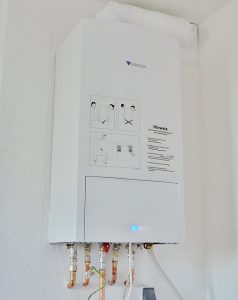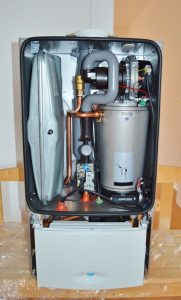A water heater can also be called a boiler, cumulus, or hot water tank.
It is a device that can produce and store hot water for domestic use: shower, bath, dishes … The tank is filled with cold water first, then according to the chosen system, the water is heated and available all day, as needed.
 Generally, the water heater is programmed so that the cold water is warmed during off-peak hours (at night) and available in total capacity of the tank in the morning (so that the whole family can take a shower for example).
Generally, the water heater is programmed so that the cold water is warmed during off-peak hours (at night) and available in total capacity of the tank in the morning (so that the whole family can take a shower for example).
Most water heaters today heat the water directly as it is used. Those are instant water heaters.
A cumulus or a hot water tank (or ” boiler ” in English) are storage water heaters. They have the advantage of consuming less energy than instantaneous water heaters. Each quantity of hot water taken during the day is replaced by cold water, which will then be reheated. The capacity of the cumulus is an important aspect: when all the available hot water is consumed, only cold water will remain, and it will be necessary to wait for the night so that the system starts to heat it again. However, there is the possibility to put the cumulus or hot water balloon forced to heat the water, including during peak hours.
The boiler is used to heat the heating appliances such as radiators, but also the clean water. The boiler can be coupled with a hot water tank or water heater. The heating power is important.
A / Directly Heated Water Heaters Directly
Heated water heaters operate independently of central heating and have their own burner. The water passes through a spiral pipe placed in the hot gases. This system is the most advantageous: the heating time is short, and the water flow is high.
B / Indirect Heating Water Heaters
 Indirectly heated water heaters operate using the central heating boiler. The heating water is sent to a plate exchanger with a very large exchange surface. The heat is instantly transferred to the clean cold water. During the period of domestic hot water draw, the heating circuit is shortened by a bypass that turns the heating water under the flame before it goes to the radiators. Advantage: almost instantaneous warming.
Indirectly heated water heaters operate using the central heating boiler. The heating water is sent to a plate exchanger with a very large exchange surface. The heat is instantly transferred to the clean cold water. During the period of domestic hot water draw, the heating circuit is shortened by a bypass that turns the heating water under the flame before it goes to the radiators. Advantage: almost instantaneous warming.
Other models operate on the same principle as the water bath: one tank in another. Hot water from the boiler that fills the outer container (water from the heating circuit) warms the water in the inner container (domestic hot water). Advantage: the reheating is softer; there is less danger of calcareous deposits. The inner tank contains hot water immediately available, but the heat transfer is slower; if the draw is huge, the temperature may drop.
The water heater (electric) can be installed in a house, an apartment, a caravan, a camper, a cabin or workshop, a camping bungalow… All points are having a water supply and a power supply.
For other types of water heater call best plumber, it’s a bit more complicated and it is important to hire professional plumber to install water heater.
